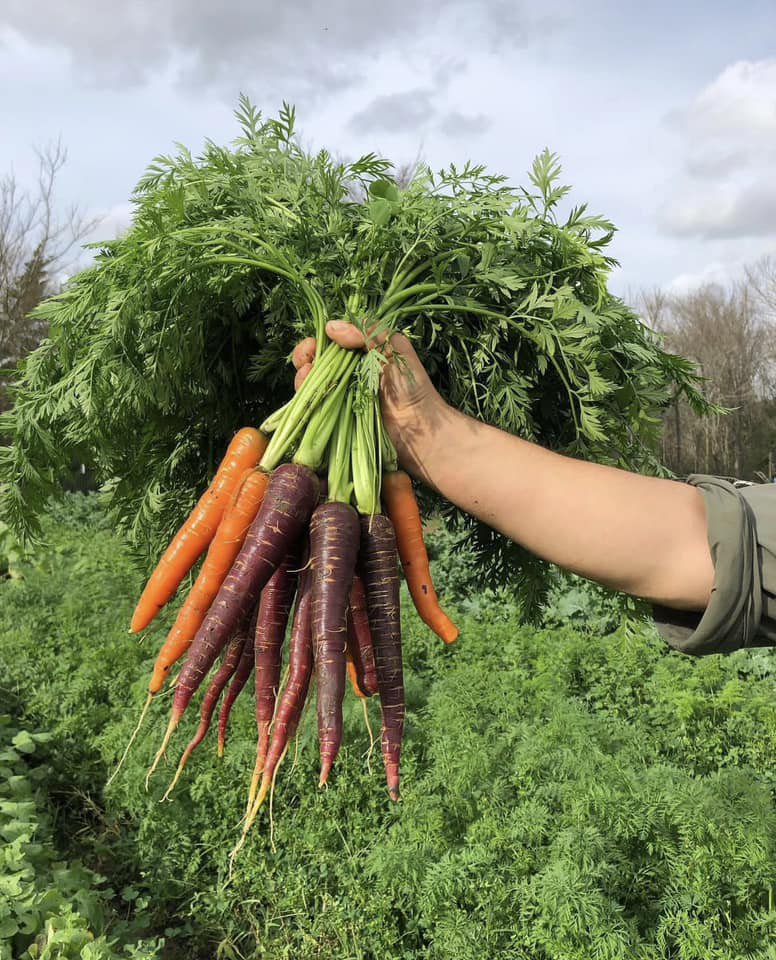Just minutes away from Texas A&M University, Urban Aggie Farm is a quick change in landscape from concrete and suburban lawns to a small oasis of fresh, rich soils. Multiple varieties of vegetables, including tomatoes, salad greens, herbs and berries are grown and harvested by hand using techniques that help maximize the full production of the land.
According to the American Farm Bureau Federation, only 2% of American farm families are farming for the rest of Americans. Local farmer Caleb Armijo shared insight on the growing need for urban farming and how everyone can contribute to the movement of connecting back to local food production.
How did you get interested in urban farming?
“I personally didn’t know how to grow a plant until I was 18, when my grandma showed me how to grow tomatoes,” Caleb says. “Before that, I didn’t even know flour came from a seed.”
After studying the way food deserts impact communities in college, Caleb knew that with just a few hundred square feet of land, he could help provide people with fresh food.
“In some communities, their first place to access food is a gas station,” Caleb says. “As we get crowded in cities or isolated in rural areas, we lose access to the means of production and fresh food becomes less available.”
What is market gardening?
Urban Aggie Farm refers to its business as a market garden because it is bigger than a home garden, yet small enough to be a human-powered production Caleb says.
“It’s all biointensive farming — growing more food with less space by creating fertile soil,” Caleb says. “Instead of growing grass lawns, we repurpose that space for local city food production. Scientists are trying to figure out how to restore soil and use places like old parking lots. There, you deal with compaction and all sorts of debilitated soils and have to be able to restore that soil and bring it back to life and grow a whole lot of food within a small square footage — that is essentially the art I started learning.”
What kinds of crops do you grow in this season?
“In our market garden, we try to grow things that have a quick turnaround,” Caleb says. “We can’t grow profit with corn, watermelons and other things that take a long season to grow. We really try to work on crops that are fast growers, especially in the wintertime. A market gardener’s greatest forte is quick greens because our production system allows for one person to maximize output.”
“We grow really yummy salad greens in the wintertime, which is why you have to know which seasons you’re in. We really like the winter season and fall season because there’s less bugs, which means we don’t have to fight them with any chemicals and a lot of our vegetables get sweetened up by the cold weather. Right now, for the summer season, we’re planting cucumbers, cantaloupe, basil, tomatoes, herbs and zucchini squash.”
Why is growing your own food better for you?
“You’re in control of what goes into growing your food. We don’t use any synthetic fertilizers or chemicals in our process, just because the greens grow so quickly within 30 days and we can harvest them a couple of different times,” Caleb says. Covering your plant with a physical barrier like insect netting or a very light frost cloth can be used to keep bad insects away, while avoiding the use of chemicals, he adds. “There’s also a whole bunch of recipes for pepper sprays as well as orange oils and Allium sprays.”
“One of the most beautiful parts about growing your own vegetables is also the taste,” Caleb says. “Veggies are best when fresh, there’s multiple varieties and you’ve got unique flavors. We make some amazing salad mixes that our customers love at the farmers market and they seem to be one of our hottest items — spicy mix or a regular MicroGreen field mix.”
How can people support local farmers?
Caleb says visiting local farmers markets like Aggieland Farmers Market and the Farmers Market in Brazos County are great ways to support farmers and help them make a profit. Most importantly, visiting could also “ignite” people’s interest in food production.
“Less than 2% of Americans are farming for the rest of us and about half of those people are over the age of 60, so it’s very necessary for youth to have an interest in America’s food security,” Caleb says.
What would you like to share with the community and those interested in growing their own food?
Creating compost is a great first step for those interested in getting started with their own urban farm, Caleb says.
“I know we just throw a lot of things down the trash, but a lot of our waste, if composted correctly, turns into black gold and into new fertilizer that we can use to
grow vegetables,” he says. “You can also set up a worm bin in your garage to create some of the best fertile soil.”
Some beginner-friendly plants Caleb recommends starting with are tomatoes, cucumbers, mint, chocolate mint, herbs, squash and microgreens.
“Urban Aggie Farm aims to engage the community to participate in their own food production,” he says. “Once you learn how to grow your own food the right way, you’re just going to get so much abundance that you can share. You can feed your family and you can feed your neighbors.”
Urban Aggie Farm sells its produce on Saturdays from 8 a.m. to noon at the weekly Aggieland Farmers Market, located at the Post Oak Mall parking lot, and The Farmer’s Market in Downtown Bryan on Saturdays from 8 a.m. to noon. To stay up-to-date on Caleb’s urban farming journey, follow him on Instagram @urbanaggiefarm or email him at urbanaggiefarm@gmail.com.




